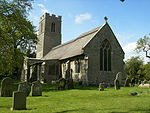Barton Turf

Barton Turf is a village and civil parish in the English county of Norfolk. It is 20 km north-east of the city of Norwich, on the northwestern edge of Barton Broad, the second largest of the Norfolk Broads. In primary local government the area is in the district of North Norfolk.The villages name means 'Barley farm/settlement'. 'Turf' is a late 14th century addition, probably indicating that turf cutting was an important local industry. The civil parish, which includes the whole of Barton Broad and the smaller village of Irstead at its southern end, has an area of 10.86 km2. In the 2001 census it had a population of 480 in 181 households, the population decreasing to 467 at the 2011 Census.Barton Turf's St Michael and All Angels Church, Barton Turf, about a mile from the clustered village centre, has a large, ornate medieval painted rood screen such as many medieval parishes who could afford fine artisans once had, but which have rarely survived the English Reformation. The 18th-century antiquarian Antony Norris lived in Barton Turf, and is buried at the church.
Excerpt from the Wikipedia article Barton Turf (License: CC BY-SA 3.0, Authors, Images).Barton Turf
Staithe Road, North Norfolk Barton Turf
Geographical coordinates (GPS) Address Nearby Places Show on map
Geographical coordinates (GPS)
| Latitude | Longitude |
|---|---|
| N 52.74796 ° | E 1.48493 ° |
Address
Staithe Road
NR12 8BB North Norfolk, Barton Turf
England, United Kingdom
Open on Google Maps








